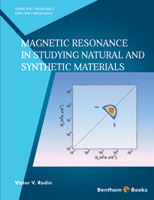Editor: Victor V. Rodin, Published on: November 2nd, 2018.
Magnetic Resonance in Studying Natural and Synthetic Materials presents valuable information for PhD students and research scientists working in the area of different applications of magnetic resonance methods..
The book is especially useful to both those who need to learn additional NMR applications and those needing to refresh their knowledge and extend their own abilities when consider NMR methods in research projects. The book goes deeply into the various NMR applications in studying natural biological and synthetic materials. NMR methods in studying diffusion properties and dynamics of molecules in polymer systems of different complexity are reported: from polymer solutions to polymer films and biomaterials of natural origin. The book describes a number of NMR methodologies in studying different heterogeneous materials. Double-quantum-filtered (DQF) NMR techniques are described for the study of slow molecular dynamics. The results of NMR study of the systems with the anisotropic properties are presented. DQF NMR works in investigating the systems, in which there is an observed order. It is effectively applied in the systems with anisotropic motion of molecules. The text presents examples of these magnetic resonance methods applied on natural silk, collagens, and materials of construction destination.
About The Author:
Victor V. Rodin initially graduated from the Moscow Institute of Physics and Technology (MIPT) in 1977. He completed his Ph.D. in Biophysics at the Research Institute of Biophysics (1986), and DSci in macromolecular and colloid chemistry from Moscow State University (1997). His research focuses on new NMR methods to study polymers, natural biopolymers, and construction materials. Rodin has worked in excellent research centers in USA (University of California), France (INRA), UK (University of East Anglia, University of Bristol, University of Surrey) and Austria (Johannes Kepler University of Linz).

